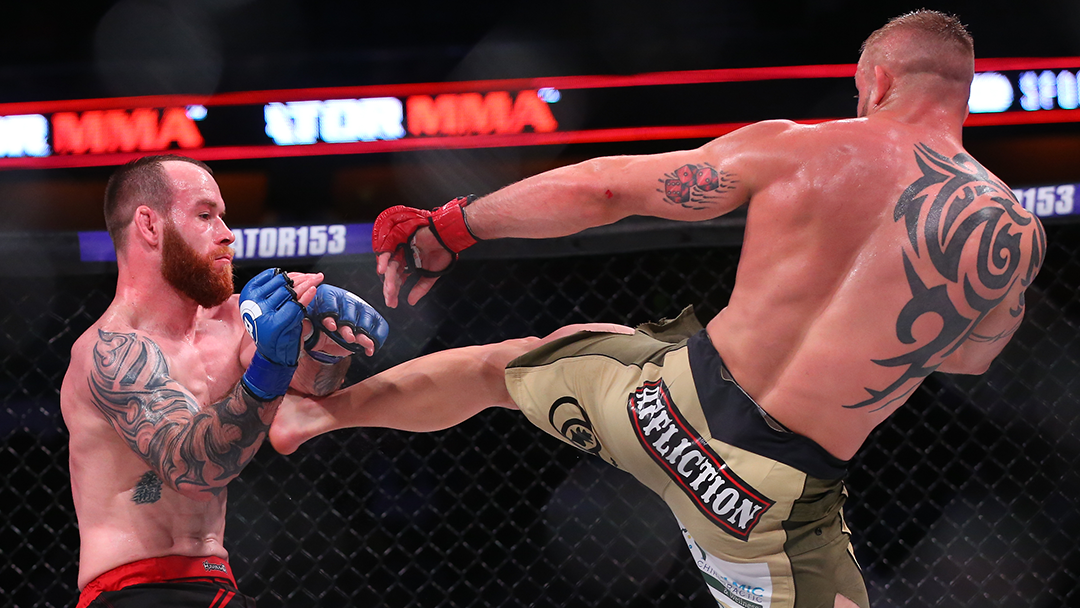Bellator MMA is a Mixed Martial Arts Promotion that recognizes and values the importance of the independent regulation of our sport. Bellator events are sanctioned and supervised by either the State or Tribal Athletic Commission, or a national federation approved and appointed by the government in the jurisdiction where the event is being held. The presiding commission assigns and supervises the referees and judges that officiate each bout. This occurs entirely independent of Bellator.
Bellator bouts are contested using the Association of Combative Sports Commissions Unified Rules of MMA or a similar version of these rules as determined by the presiding commission.
10–10 Round
“A 10 – 10 round in MMA is when both fighters have competed for whatever duration of time in the round and there is no difference or advantage between either fighter.” A 10 – 10 round in MMA should be extremely rare and is not a score to be used as an excuse by a judge that cannot assess the differences in the round. A 10 – 10 round in MMA is a necessity to have for the judge’s possible score, mainly due to scoring incomplete rounds. It is possible to have a round where both fighters engage for 5 minutes and at the end of the 5-minute time period the output, impact, effectiveness and overall competition between the two fighters is exactly the same. It is possible, but highly unlikely. If there is any discernable difference between the two fighters during the round the judge shall not give the score of 10 – 10. Again, this score will be extremely rare.
10–9 Round
“A 10 – 9 Round in MMA is where one combatant wins the round by a close margin.” A 10 – 9 round in MMA is the most common score a judge assesses during the night. If, during the round, the judge sees a fighter land the better strikes, or utilize effective grappling during the competition, even if by just one technique over their opponent, the judge shall give the winning fighter a score of 10 while assessing the losing fighter a score of 9 or less. It is imperative that judges understand that a score of 9 is not an automatic numerical score given to the losing fighter of the round. The judge must consider: Was the fighter engaged in offensive actions during the round? Did the losing fighter compete with an attitude of attempting to win the fight, or just to survive the offensive actions of their opponent? A score of 10 – 9 can reflect an extremely close round or a round of marginal domination and/or impact.
10–8 Round
A 10 – 8 Round in MMA is where one fighter wins the round by a large margin. A 10 – 8 round in MMA is not the most common score a judge will render, but it is absolutely essential to the evolution of the sport and the fairness to the fighters that judges understand and effectively utilize the score of 10 – 8. A score of 10 – 8 does not require a fighter to dominate their opponent for 5 minutes of a round. The score of 10 – 8 is utilized by the judge when the judge sees verifiable actions on the part of either fighter. Judges shall always give a score of 10 – 8 when the judge has established that one fighter has dominated the action of the round, had duration of the domination and also impacted their opponent with either effective strikes or effective grappling maneuvers that have diminished the abilities of their opponent.
Judges must consider giving the score of 10 – 8 when a fighter shows dominance in the round even though no impactful scoring against the opponent was achieved. MMA is an offensive based sport. No scoring is given for defensive maneuvers. Using smart, tactically sound defensive maneuvers allows the fighter to stay in the fight and to be competitive. Dominance of a round can be seen in striking when the losing fighter continually attempts to defend, with no counters or reaction taken when openings present themselves.

Dominance in the grappling phase can be seen by fighters taking dominant positions in the fight and utilizing those positions to attempt fight ending submissions or attacks. If a fighter has little to no offensive output during a 5 minute round, it should be normal for the judge to consider awarding the losing fighter 8 points instead of 9. Judges must consider giving the score of 10 – 8 when a fighter impacts their opponent significantly in a round even though they do not dominate the action. Effectiveness in striking or grappling which leads to a diminishing of a fighter’s energy, confidence, abilities and spirit. All of these come as a direct result of negative impact.
When a fighter is hurt with strikes, showing a lack of control or ability, these can be defining moments in the fight. If a judge sees that a fighter has been significantly damaged in the round the judge should consider the score of 10 – 8.
Impact
A judge shall assess if a fighter impacts their opponent significantly in the round, even though they may not have dominated the action. Impact includes visible evidence such as swelling and lacerations. Impact shall also be assessed when a fighter’s actions, using striking and/or grappling, lead to a diminishing of their opponents’ energy, confidence, abilities and spirit. All of these come as a direct result of impact. When a fighter is impacted with strikes, by lack of control and/or ability, this can create defining moments in the round and shall be assessed with great value.
Dominance
As MMA is an offensive based sport, dominance of a round can be seen in striking when the losing fighter is forced to continually defend, with no counters or reaction taken when openings present themselves. Dominance in the grappling phase can be seen by fighters taking dominant positions in the fight and utilizing those positions to attempt fight ending submissions or attacks. Merely holding a dominant position(s) shall not be a primary factor in assessing dominance. What the fighter does with those positions is what must be assessed.
In the absence of dominance in the grappling phase, as set forth in paragraph 3 of the promulgated rules, to be considered dominate, there must be a singularly or in combination, some types of submission attempts, strikes, or an overwhelming pace which is measured by improved or aggressive positional changes that cause the losing fighter to consistently be in a defensive or reactive mode.

Duration
Duration is defined by the time spent by one fighter effectively attacking, controlling and impacting their opponent; while the opponent offers little to no offensive output. A judge shall assess duration by recognizing the relative time in a round when one fighter takes and maintains full control of the effective offense. This can be assessed both standing and grounded.
10–7 Round
“A 10 – 7 Round in MMA is when a fighter completely overwhelms their opponent in Effective Striking and/or Grappling and stoppage is warranted.” A 10 – 7 round in MMA is a score that judges will rarely give. It takes both overwhelming dominance of a round, but also significant impact that, at times, cause the judge to consider that the fight could be stopped. Judges shall look for multiple impactful blows or knockdowns that diminish the fighter, and/or grappling maneuvers that place the fighter in dominant situations with impact being inflicted that visibly diminishes the fighter’s ability to compete.
** As of 2019 Unified Rules





























